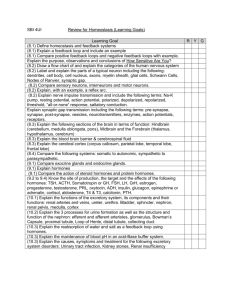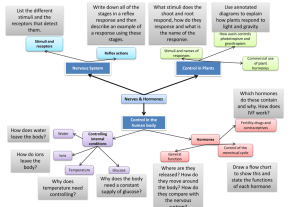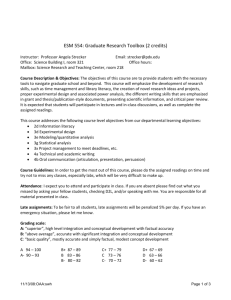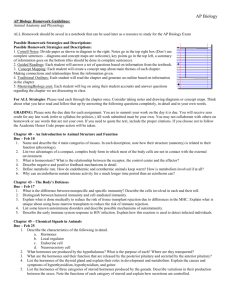Hormones and Behavior - Behavioral Endocrinology
advertisement
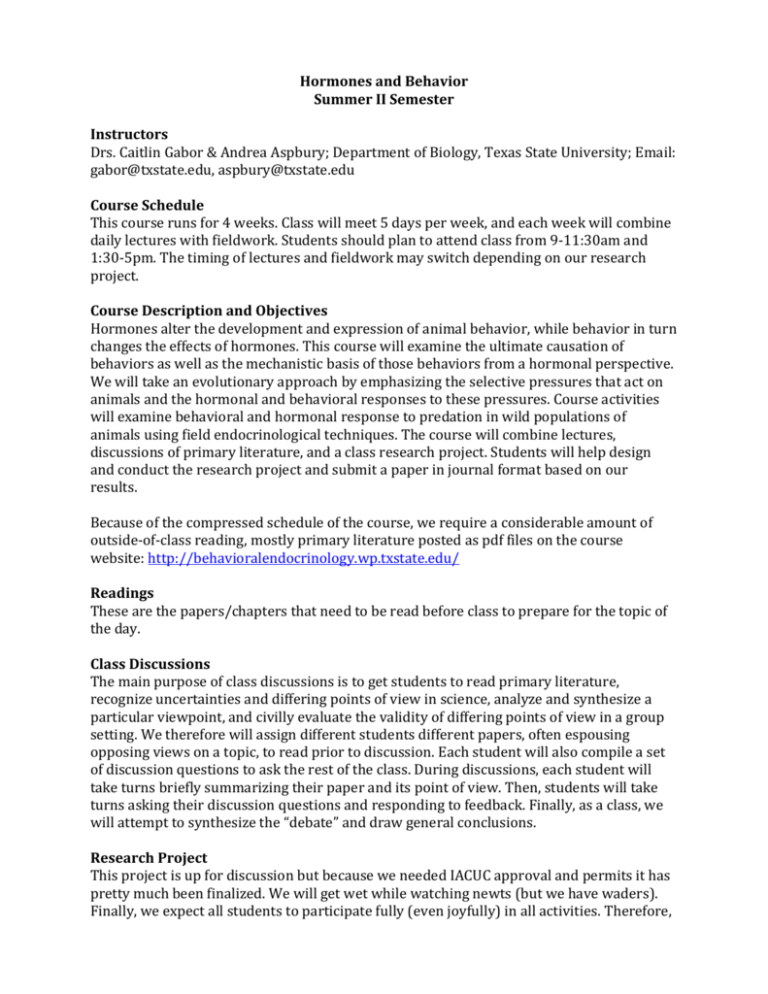
Hormones and Behavior Summer II Semester Instructors Drs. Caitlin Gabor & Andrea Aspbury; Department of Biology, Texas State University; Email: gabor@txstate.edu, aspbury@txstate.edu Course Schedule This course runs for 4 weeks. Class will meet 5 days per week, and each week will combine daily lectures with fieldwork. Students should plan to attend class from 9-11:30am and 1:30-5pm. The timing of lectures and fieldwork may switch depending on our research project. Course Description and Objectives Hormones alter the development and expression of animal behavior, while behavior in turn changes the effects of hormones. This course will examine the ultimate causation of behaviors as well as the mechanistic basis of those behaviors from a hormonal perspective. We will take an evolutionary approach by emphasizing the selective pressures that act on animals and the hormonal and behavioral responses to these pressures. Course activities will examine behavioral and hormonal response to predation in wild populations of animals using field endocrinological techniques. The course will combine lectures, discussions of primary literature, and a class research project. Students will help design and conduct the research project and submit a paper in journal format based on our results. Because of the compressed schedule of the course, we require a considerable amount of outside-of-class reading, mostly primary literature posted as pdf files on the course website: http://behavioralendocrinology.wp.txstate.edu/ Readings These are the papers/chapters that need to be read before class to prepare for the topic of the day. Class Discussions The main purpose of class discussions is to get students to read primary literature, recognize uncertainties and differing points of view in science, analyze and synthesize a particular viewpoint, and civilly evaluate the validity of differing points of view in a group setting. We therefore will assign different students different papers, often espousing opposing views on a topic, to read prior to discussion. Each student will also compile a set of discussion questions to ask the rest of the class. During discussions, each student will take turns briefly summarizing their paper and its point of view. Then, students will take turns asking their discussion questions and responding to feedback. Finally, as a class, we will attempt to synthesize the “debate” and draw general conclusions. Research Project This project is up for discussion but because we needed IACUC approval and permits it has pretty much been finalized. We will get wet while watching newts (but we have waders). Finally, we expect all students to participate fully (even joyfully) in all activities. Therefore, part of your class grade will be based on your active participation in research. Grading 100 points participation in paper discussions 100 points for participation in research activities 10 points: Methods section of paper draft 10 points Introduction, Methods, and Results sections drafts 30 points complete rough draft of paper 50 points final draft of paper A: 270-300 points B: 240-269 points C: 210-239 points Keys for Success Any motivated student should have no trouble being successful in this class. We define success by how much a student learns, not by how much we “teach”. If you meet the learning objectives of this class, you will have succeeded in the class, and your grade will reflect it. The keys for learning and success are to: Be curious; eager to learn new things Maintain a positive, respectful attitude towards others Be flexible if plans change Talk about things you’re learning in class with classmates and faculty Go to the nightly seminars in the MLBS seminar series Ask questions in and out of class Put equal care into listening and speaking during class discussions Complete all readings and assignments on time Show up to class on time Keep tidy, comprehensive field, data, and in-class notes Working with Animals Because we are working with animals, our activities are subject to the regulations and safeguards of the Virginia Department of Game and Inland Fisheries (VDGIF) and the Institutional Animal Care and Use Committee (IACUC) of UVA. Violation of the terms of these permits by any student or me is strictly prohibited. We may intentionally sacrifice some individuals for validation of the techniques we are using. If you have ethical concerns about these activities, please contact me as soon as possible. Date 6-15 Research Activities Introduction to the study system Find P. cinereus 6-16 6-22 Water-borne hormone collection methods Validation and extraction of P. cinereus Female behavior ethogram (video) Get CORT Set-up field experiments Watch behavior Run validation plate Watch behavior Watch behavior 6-23 Watch behavior 6-24 Watch behavior 6-25 Get CORT Switch field treatments Watch behavior Watch behavior Extract hormones 6-17 6-18 6-19 6-26 6-29 6-30 7-1 7-2 7-3 Watch behavior Extract hormones Run 2 hormone plates Watch behavior Data Analysis Watch behavior GET CORT and take down experiment 7-7 Extract and prepare samples Run 2 hormone plates Data Analysis Finish data analyses 7-8 7-9 Go to VT?? Clean up /go to VT?? 7-6 7-10 Lecture Topics Behavioral Ecology Scientific Method Red-spotted newt natural history Endocrine System Hypothesis and prediction for experiment Readings Davies et al. CH 1 and 2 Verrell (1983) Masssey (1988) Class Discussions How to read primary literature Pechenik CH 1-3 Nelson CH 2 Cort KIT EIA Gabor et al. (2013) Scott & Ellis (2007) Grayson (2012) Reedy et al. (2014) Stress and control of behavior Stress and control of behavior Nelson CH 11 Sapolsky et al. (2000) Romero et al. (2009) Lendvai et al. (2013) Davis & Gabor (2015) Bliley & Woodley (2012) Riciardella et al. (2010) Male Reproductive Behavior Female Reproductive Behavior Sexual selection Part 1 Sexual selection Part 2 Social Behavior and hormones Nelson CH 5 Leary et al. (2008) Orchinik et al. (1988) Rollman et al. (1999) Knapp et al. (2010) Behavioral Syndromes and Hormones Writing Sih (2011) Koolhaas et al. (2010) Archard et al. (2012) Furtbauer et al. (2015) Pechenik CH 9 Writing Methods section Statistics and writing Pechenik CH 4 Writing Conservation and stress hormones Pechenik CH 5 Cooke et al. (2013) (maybe not) Writing Results section DUE: Methods draft (email by 9 AM) Writing Introduction section Fefferman & Romero (2013) Busch & Hayward (2009) DUE: Intro, Methods, Results draft (email by 9 AM) Writing Pechenik CH 6 Data analyses and discuss results Writing Nelson CH 6 Davies et al CH 7 Nelson CH 8 Pechenik 6 Rohr et al. (2005) Roberts et al. (2007) Gabor et al. (2000) Able et al. (1999) Pradham et al. (2013) Earley et al. (2006) Work on writing Discussion sections DUE: Complete rough draft (email by 9 AM) Peer evaluation of papers DUE: Complete final draft (email by 4 PM) Paper Reading Techniques General advice to all participants: Be critical. Bear in mind the distinction between a review and a critical review. Note the major objectives of the study and after you have finished critically evaluating the paper determine whether these objectives were met. Note and distinguish between major/minor flaws of the research. Consider the adequacy of the experimental design and the techniques employed. Pay attention to statistical considerations, e.g., replication, sample size, realism of the treatments, etc. Determine whether the hypotheses that were actually tested were valid tests of the stated null hypotheses. Judge whether the presentation of results accurately represents what data actually say. Ask yourself, “Am I convinced by the story the authors created based on the data? Have the authors taken too much latitude in interpreting their data?” (Note: the data and the story authors create based on data don’t always come to the same happy ending.) Look for points that were glossed over or were buried that should have been more fully presented or developed. Identify what the next step in the research program should be. Ask yourself “What didn’t I understand about this paper?” A lot of what is learned in seminars originates from discussion of the grey areas of our understanding of the research. Try to identify reasons for the above: (1) poor writing and explanations; (2) incomplete description of methodologies; (3) unfamiliar experimental and/or statistical techniques. Advice for presenters: Be thoroughly familiar with the paper(s) Be prepared to initiate and direct the discussion. Read the paper as if reviewing it for a journal. Think about what is new, what is good, what is bad, what sort of errors there are and what needs fixing. If the discussion bogs down or begins to wander excessively or you feel the need to move to other aspects of the research, don’t hesitate to redirect the attention of the class. Be prepared to support your arguments. The best way to do so is to read the material carefully. You may also need to consult additional, outside readings for opposing views or to clarify points made in the assigned reading. A brief introduction, history, or context of the work is OK but limit introductory comments to a few minutes. Outline the paper and use the outline to guide your presentation where necessary. Be fair to the author’s arguments. Present the author's position first––and fairly–– before providing counter-arguments. Discuss why the paper is important Advice to non-presenters Read the paper well in advance of class. (Note: glossing over a paper is not a substitute for reading it.) It is not a sin to read a paper more than once While reading the paper write down your comments for discussion, (e.g., questions, insights, or clarifications needed) and bring them to class. Don’t wait until class begins to look for something to talk about. Reminders for Paper Writing by Dr. Robert Jaeger 1. The word “data” is plural 2. Do not use a species name with a plural verb NO! Eurycea nana do not occur co-occur with any other species of salamander YES! Eurycea nana does not occur co-occur with any other species of salamander 3. Do not use a species’ name as an adjective NO! Eurycea nana salamanders ... YES! Wild males of E. nana reach sexual maturity ... NO! Male Desmognathus ochrophaeus salamanders prefer large females ... YES! Male salamanders, Desmognathus ochrophaeus, prefer large females .. 4. Do not split infinitives NO! I need to first examine some basic reproductive questions YES! I need first to examine some basic reproductive questions 5. Do not use teleologies NO! Males try to mate with bigger females YES! Males show a greater preference to mate with bigger females



